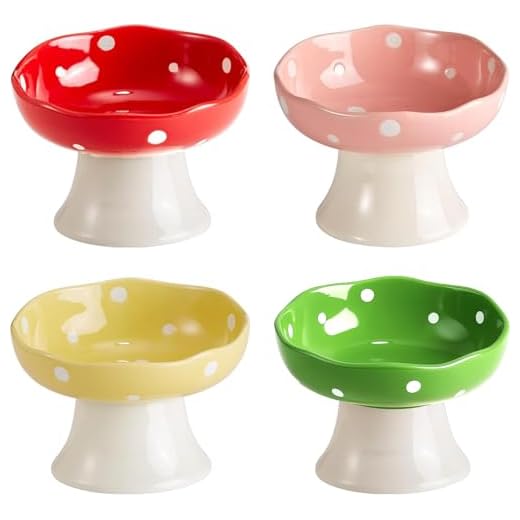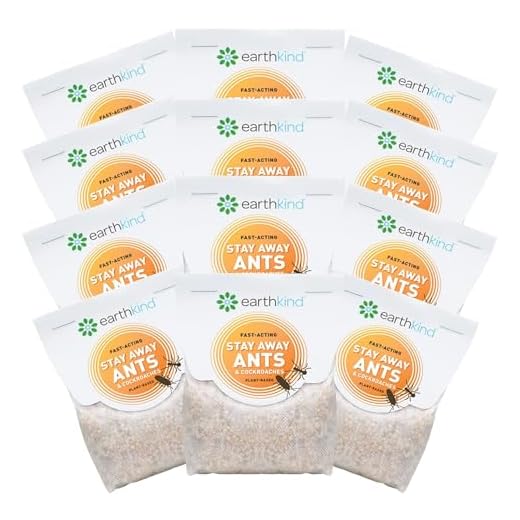



Place a shallow dish filled with soapy water around the area where the dining setup is located. The soap breaks the surface tension, making it difficult for little creatures to escape once they touch the liquid. This simple barrier can deter them from approaching the meal.
Consider using a raised platform for the feeding area. Elevating the dish makes it harder for unwanted visitors to reach the scrumptious delights. Additionally, ensure the surrounding surface is clean and free from crumbs, as these can attract uninvited guests.
Utilize natural repellents, such as vinegar or citrus sprays, around the perimeter of the feeding zone. Both scents are unpleasant for many insects. A light mist can create an invisible shield that keeps them at bay while remaining safe for your furry friend.
Lastly, monitor the feeding times and remove any leftovers after the meal. Leaving out uneaten portions can serve as an open invitation. Regular cleaning of the area will help maintain a tidy space, further discouraging any intruders.
Solutions for a Clean Feeding Area
Place the dish on a tray filled with soapy water. This creates a barrier that prevents tiny creatures from reaching my meal. It’s simple and works well. Make sure to check the tray regularly to keep it effective!
Consider using a pet-safe insect repellent around the feeding zone. Natural ingredients, like peppermint oil or vinegar, can deter unwanted visitors without harming me. Just a few drops around the area will help keep it clear.
Regular Clean-Up Routine
After each meal, clean the dish thoroughly. Residue attracts unwanted visitors, so a quick wash with soap and water is necessary. A clean bowl means fewer chances for troublesome bugs to invade.
Feeding Schedule
Establish a routine for meals. Leaving the dish out all day invites trouble. By feeding at specific times and removing leftovers immediately, I can enjoy my meals without uninvited guests!
Identifying the Source of Intruders in My Meal Dish
To tackle unwanted visitors, first, determine where they are coming from. Inspect the area around my dining space for trails or clusters. These little beings often follow pheromone paths, so spotting a line leading to a crack or crevice can reveal their entry point.
Checking for Attractants
Next, assess any potential attractants nearby. Crumbs or spills on the floor can easily lure them in. Ensure the surrounding environment is clean and free from any debris that might invite them to the vicinity of my feeding station.
Inspecting Food Storage
Examine the storage of my meals as well. If any packages are open or damaged, seal them tightly. I recommend using airtight containers to prevent any aroma from escaping, which could entice these critters. Keeping my supplies secure helps maintain a pest-free zone for my dining experience. For more tips on maintaining a clean environment, check out how to lower nitrates in saltwater aquarium quickly.
Choosing Ant-Repellent Cat Food Bowls
Opt for a food dish with a raised design. These bowls often create a barrier that prevents little intruders from accessing the meal. Look for options with a wider base, as they are less likely to be tipped over or moved around.
Materials Matter
- Stainless steel is a great choice. It’s sturdy and easy to clean, plus it doesn’t hold onto odors.
- Silicone mats can be effective when placed underneath bowls, creating a non-slip surface that helps in keeping everything in place.
- Some ceramic dishes come with a protective glaze that can deter unwanted visitors.
Special Features
- Consider bowls with a moat design. These bowls have an outer ring filled with water, creating a barrier that pests can’t cross.
- Look for dishes that are elevated on a stand. This height can make it harder for critters to reach the contents.
- Some bowls have lids or covers that keep the meal fresh and protected, limiting access to uninvited guests.
Selecting the right dining set can make a big difference in keeping your meals safe. Focus on functionality and materials that naturally resist intrusion, ensuring a peaceful dining experience for me.
Implementing Cleaning Routines for Feeding Areas
Establishing a consistent cleaning schedule for my dining space is a game changer. I recommend wiping down the area after each meal. A damp cloth with mild soap works wonders to remove crumbs and residue, preventing unwanted visitors.
Daily inspections are crucial. I check for any spills or leftover morsels that might attract intruders. If something spills, it’s best to clean it immediately. This simple act stops problems before they escalate.
Weekly deep cleaning is another step I follow. I wash all dishes in warm, soapy water, ensuring they are free from sticky spots. I also clean the surrounding floor area with a pet-safe cleaner to eliminate any lingering scents that might beckon unwelcome guests.
Consider using a mat under the dishes. It helps catch stray bits and makes cleanup easier. Regularly shaking it out or washing it keeps my dining area tidy and less inviting for unwanted guests.
Lastly, storing my meals in airtight containers prevents any scent from escaping, which is key in keeping the area less appealing to opportunists. This way, I can enjoy my meals in peace!
Natural Remedies to Deter Ants from Cat Food
Vinegar is a fantastic option. Mixing equal parts of water and vinegar in a spray bottle and applying it around the feeding area creates a barrier. Ants dislike the strong scent, which helps keep them away.
Cinnamon is another effective deterrent. Sprinkling ground cinnamon around the feeding spot can disrupt their trails and prevent them from venturing close. The aroma acts as a natural repellent.
Essential oils work wonders too. Peppermint or tea tree oil diluted with water can be sprayed around the dish. A few drops on cotton balls placed nearby can enhance the effect. These scents are unpleasant for those tiny invaders.
Bay leaves placed near the meal area can deter unwanted visitors. The smell is unappealing to them, and this simple herb can act as a natural barrier.
Another option is using chalk. Drawing a line around the feeding zone creates a barrier that these little creatures hesitate to cross. The calcium carbonate in chalk disrupts their navigation.
| Remedy | Application | Effectiveness |
|---|---|---|
| Vinegar | Spray around area | High |
| Cinnamon | Sprinkle around dish | Moderate |
| Essential Oils | Spray or place on cotton balls | High |
| Bay Leaves | Place near feeding area | Moderate |
| Chalk | Draw a line | Moderate |
Using these natural options can keep the feeding area safe and clean, allowing for a peaceful dining experience without unwanted guests. Always ensure that none of these remedies pose a risk to your health or well-being.
Using Commercial Ant Baits Safely Around Pets
For effective pest control while ensuring safety for furry companions, select commercial baits specifically labeled as pet-safe. Always read the packaging carefully to confirm it meets safety standards for animals.
Here are some specific guidelines to consider:
- Choose baits that use slow-acting poisons. This allows pets to avoid immediate toxicity and gives you time to monitor their behavior.
- Place bait stations in areas inaccessible to pets. High shelves or enclosed cabinets work well.
- Monitor the bait stations regularly. Ensure they remain intact and are not disturbed by curious paws.
- Keep an eye on your pet’s health. If you suspect ingestion of any toxic substances, contact your veterinarian immediately.
Consider using bait stations with child-resistant features, which can also deter pets. If you have concerns about chemicals, explore natural alternatives or consult with pest control professionals for pet-safe options.
After addressing pest issues, maintain cleanliness around feeding areas. Regularly clean up spills and crumbs to minimize attraction, ensuring your furry friend enjoys their meal without unwanted visitors.
For grooming needs, check out the best nail clippers for cats to keep those claws in check while you manage pesky pests.
Preventing Future Infestations in Feeding Areas
Seal any gaps or cracks in the walls or floors near the feeding station. This minimizes entry points for intruders.
Implement a designated feeding time, removing uneaten portions after a set duration. This discourages foragers from returning.
Utilize elevated feeding dishes to make access more challenging for unwanted visitors. A slight height can deter many pests.
Place a mat under the feeding area to catch spills and crumbs, making cleanup easier and reducing attractants.
Consider using barriers, like a line of diatomaceous earth around the feeding area. This natural substance is safe for pets and acts as a deterrent.
Regularly inspect the surrounding environment for any signs of nests or trails leading to the feeding location. Quick action on identification can prevent larger issues.
Store dry kibble in airtight containers to maintain freshness and eliminate odors that might attract intruders.
Rotate the location of the feeding area periodically. This prevents the establishment of a consistent trail for unwelcome visitors.
Incorporate strong scents like cinnamon or peppermint around the feeding zone. These aromas can repel certain critters without harming companions.









